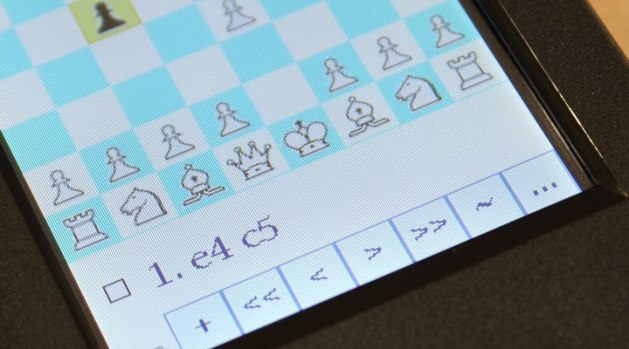Prior to 2009, I was a die-hard Windows user. Once a year I would order a collection of parts from NewEgg and Tiger Direct to build myself a custom PC or upgrade an older system with new memory or storage space. In addition to my custom desktop machine, I would carry around a Toshiba Windows laptop and I also had an early edition Acer AspireOne 10″ netbook with a keyboard almost too small for my hands. In the Spring of 2009, I began experimenting with Apple products thanks to my new obsession with my iPod Touch. It was not long before every computer in my home sported the i-prefix: an iMac desktop machine, a Macbook, and countless iPods and iPads. It was at that time when my chess studies waned significantly and I refocused myself to studying the Bible and working on my Masters of Divinity. This type of study lent itself well to the Apple ecosystem with Logos Bible Software running with lightning-fast precision on my MacBook Air.
However, my interest in chess took center stage in 2014 when I started OffMyChess.com and began a serious and regimented focus on my chess studies. I soon realized that the Apple ecosystem, as beautiful as it is, remains a wasteland of broken chess interfaces and is devoid of any true competitor to ChessBase, the king of chess databases. Unfortunately, ChessBase runs only on Windows PCs and I learned the hard way that it is not compatible with Windows emulation software such as CrossOver. I was able to successfully install ChessBase Reader 2013 on my MacBook Air under OS X Mavericks, but the full edition of ChessBase 12 and Deep Fritz 14 simply would not install on the system without resorting to extreme measures. At the end of this post, I will examine two ways that I have learned to use ChessBase in combination with the Apple ecosystem and offer tips on how it is possible to run full-edition ChessBase and all ChessBase products within OS X itself.

OS X Chess
In my opinion, there is very little to say about this program. It is a visual and cognitive disgrace that I am surprised has consistently passed the rigorous quality assurance processes in Cupertino. The Apple computer line has long prided itself as the preference of intellectuals and artists, which are two categories that encompass a significant portion of the chess community. Chess is the most popular mind sport in the world1, it is difficult to imagine why Apple did not dedicate a little more time and effort to refining the appearance and function of this program. Even Winboard and its derivatives are more useful for even the moderately responsible chess player than this program. There are no portable game notation (PGN) options in this program, which is pretty much a necessity when playing to improve. If a simple game of chess with basic functions and below-average playing skill and strength, then let the default chess program in OS X answer your prayers.

Shredder for OS X
Shredder is an immensely strong chess engine that has user interfaces available for Mac, Windows, iOS, and Android. I used Shredder on iOS to practice my tactics for years before migrating to chess on the desktop. However, the OS X chess user interface and overall implementation of Shredder on the Mac is truly horrific. The program itself is split into multiple windows, which is an old-school way of creating OS X applications. The lack of a unified interface makes it difficult to work with games and in trial runs with OS X Mavericks and Yosemite, there seemed to be a myriad of stability issues that made the entire user experience less than stellar.

A ChessBase-like Database?
Apple’s reputation for creating first-class operating systems and computer hardware does not extend to most of its applications. Utilities available to manage files and hardware in OS X are among the best out there, but Apple’s applications are often lacking key features and dependent on specific hardware configurations to work. This has left the open source community to pick up the pieces that are often lacking in OS X. The curiously titled Shane’s Chess Information Database (SCID) is perhaps as close as a person can get to having a native version of ChessBase running under OS X. The program is incredibly stable, has excellent support from its community contributors over at SourceForge and contains many useful features necessary for serious chess study. SCID also features an interface for using the Free Internet Chess Server. If there was simply no way to access ChessBase resources on a Mac, then SCID or a combination of SCID and HiARCS Chess Explorer would be the way to go.

HiARCS Chess Explorer
In the world of computer chess, there remains a dispute over the title of the reigning chess engine champion. In the not too distance past, Rybka, which boasted that it was the strongest engine ever created, had its World Computer Chess Championship title stripped when it was revealed that some of the code lines were plagiarized from another engine. These days, the HiARCS chess engine is the reigning computer chess World Champion, and its authors have created native user interfaces for both Microsoft Windows and OS X. These interfaces are identical on both operating systems, which makes HiARCS Chess Explorer the best native OS X chess interface out there. This program utilizes the HiARCS chess engine by default, but easily allows for the installation of 3rd-party universal chess interface (UCI) engines such as Stockfish, Shredder, Rybka, and older versions of Fritz. The database options in the program are basic, but highly functional for collecting and analyzing different games. I also found great use of the engine match function where the user can program two chess engines to compete against each other. HiARCS Chess Explorer is a light in the dark chasm of OS X chess, and it is probably the best bang for your buck if the user seeks something strictly native to OS X.
ChessBase Under OS X
The only way to access ChessBase or its myriad of DVDs and resources is to install a program that allows crossover applications from Microsoft Windows to function on OS X. The most popular (and stable) of these options are CrossOver and Oracle VM VirtualBox. However, each of them have some limitations that must be considered when installing and operating ChessBase:

CrossOver
- This application installs on OS X and allows native integration for Windows-based programs with OS X. The major limitation to this program is that it creates virtual bottles where individual operating system settings are stored and virtual drives are created to install Windows-based programs. I made several attempts to install ChessBase 12 and Deep Fritz 14 on OS X using CrossOver, but the installer failed on each attempt. Fortunately, I was successful at installing ChessBase Reader, which is included with every edition of ChessBase Magazine. However, this is the extent to which ChessBase is available as a natively integrated OS X application.
Oracle VM VirtualBox
- By far, this is the most effective way that I have found to install and use Windows-based software on OS X. Using VirtualBox, the end user can create a virtual computer to install a myriad of operating systems including multiple Windows and Unix flavors. The program itself contains multiple control options that allow the user to determine the amount of RAM, hard drive space, and processor resources used to run the software. There are some limitations that must be considered before taking this route:
- The user must own a legal copy of a compatible Windows operating system.
- If installing on a MacBook Air, the user should be mindful of hard drive space requirements to install a Windows operating system, ChessBase, and its database extensions. To alleviate this problem, I recommend installing the operating system on the Air’s SSD and using a 128 GB SD card as an external hard drive to install ChessBase databases, DVDs, and ChessBase Magazines.
- Running Windows on OS X will have a significant impact on a MacBook’s battery life, so close attention should be paid to the amount of power being utilized for analysis and game annotation.
- By far, this is the most effective way that I have found to install and use Windows-based software on OS X. Using VirtualBox, the end user can create a virtual computer to install a myriad of operating systems including multiple Windows and Unix flavors. The program itself contains multiple control options that allow the user to determine the amount of RAM, hard drive space, and processor resources used to run the software. There are some limitations that must be considered before taking this route:
Without a doubt, the best chess experience on an Apple computer comes in the form of the Windows environment. If the user owns a MacBook or MacBook Air and does not want to run Windows in a virtual environment under OS X, then the option to install Windows under BootCamp is available. This allows the user to install Windows on a separate hard drive partition and run the operating system without running OS X. As with the limitations of running Windows in VirtualBox under OS X, the user must own a legal copy of Windows and install it on the BootCamp partition for this to work properly.
Wrapping This Up
The OS X chess experience is less than stellar, which was a huge disappointment for me when I transitioned from Microsoft Windows to exclusively using Mac products. Much of the chess software available on the Mac will perform basic functions, but do not come close to the depth of function and resources that ChessBase and similar applications offer on the Windows platform. Hopefully ChessBase, ChessOK, and other companies will realize the growing OS X audience and offer alternatives to running this programs exclusively on the Microsoft platform. Until then, those of us in the Apple ecosystem will have to step outside of the walled garden to find our slice of heaven on the board.
-
Raymond Keene, Chess Secrets (The Times Little Books) (London, UK: HarperCollins, 2013), 1. ↩


































